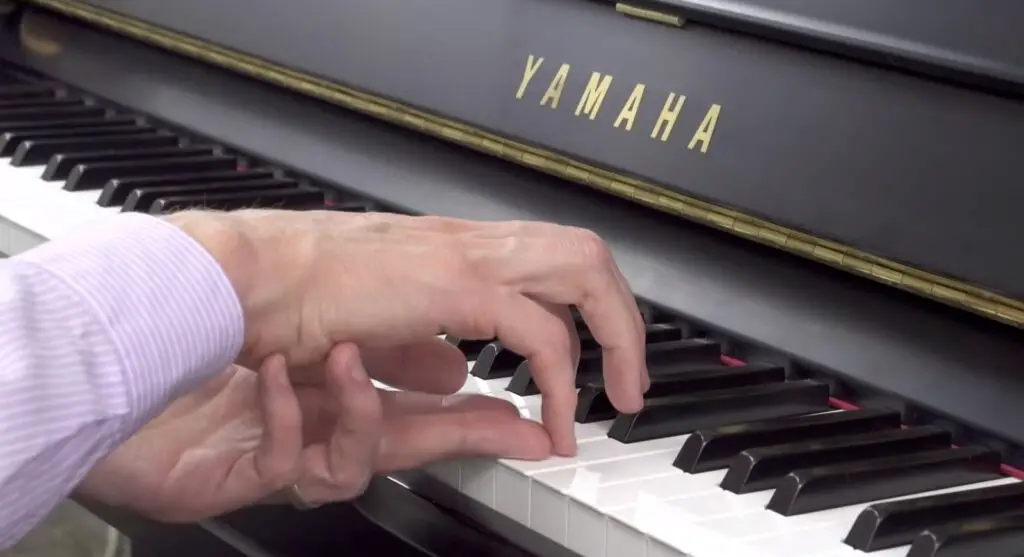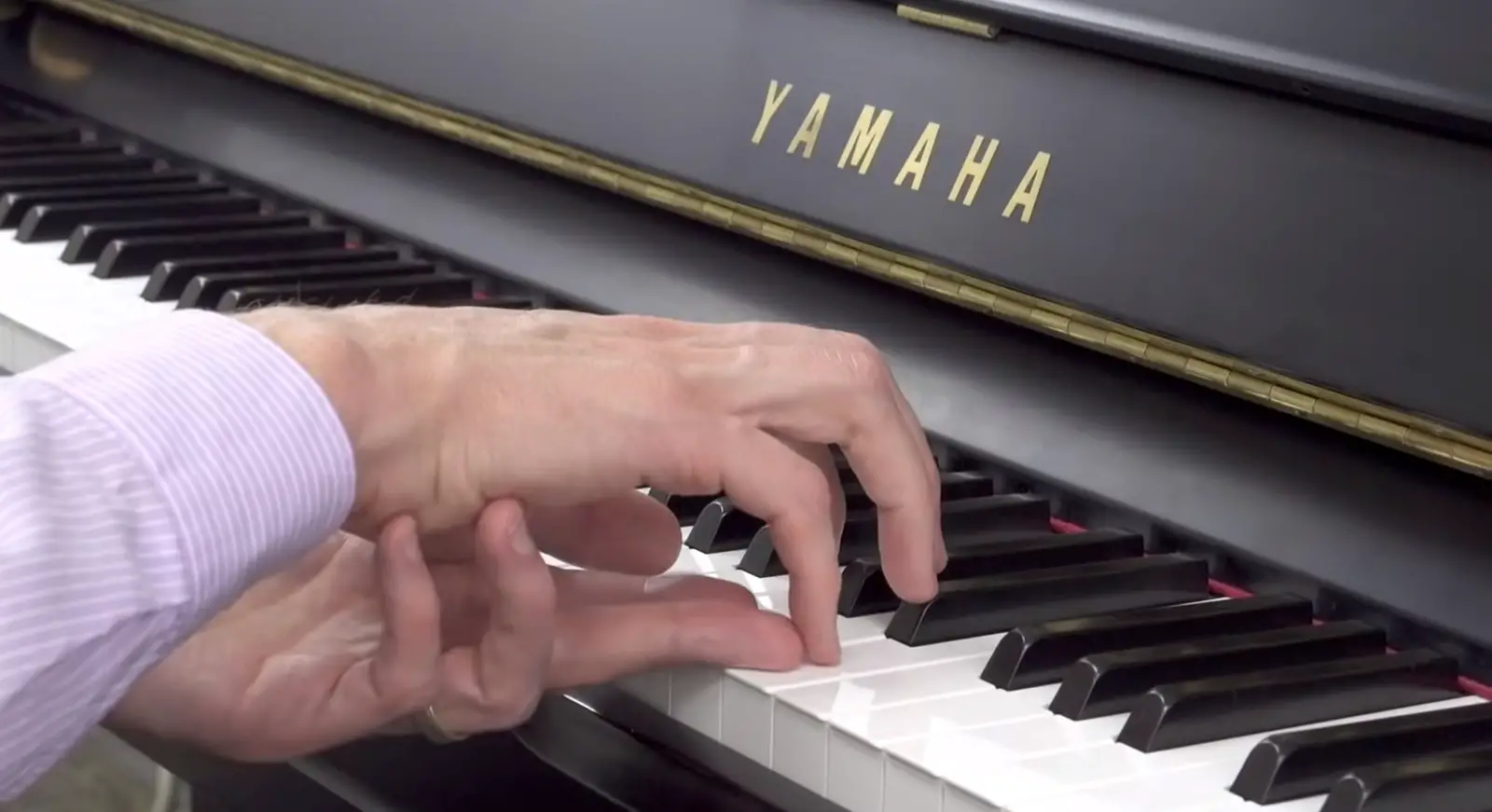The piano, with its vast array of keys, is a canvas for musicians to paint aural landscapes, and their brushes are their hands. The hands of a pianist are fascinating instruments in their own right, capable of creating beautiful harmonies and intricate melodies. Yet, they are often overlooked in favor of the music they produce.
What are piano hands?
“Piano hands” refer to the physical attributes and skills developed through playing the piano, including increased finger dexterity, flexibility, and sometimes a larger span between fingers, enabling the pianist to reach more keys simultaneously.
This article aims to shine the spotlight on these unsung heroes, exploring how the art of piano playing shapes and defines them. We look into the characteristics of ‘pianist hands,’ discussing the physical attributes, changes, and skills developed through years of practice.
We also investigate common myths and realities surrounding the impact of piano playing on hand structure and function. Join us on this unique journey as we unravel the secrets behind the hands that create harmony.
Related Content: Playing Piano with Both Hands

Pianist Hands Vs Normal Hands
Hand structure and conditioning can be different for pianists when compared to people who don’t play the piano. Here are a few ways how:
- Stretch and Flexibility: Pianists often have more flexible hands and fingers due to the constant stretching and reaching they do on the keyboard. They are able to span larger distances between fingers than most people. This does not necessarily mean that pianists have larger hands. Flexibility and span are more about conditioning and practice than inherent size.
- Strength and Endurance: The muscles in a pianist’s hand, wrist, and forearm are often stronger and have more endurance than those in people who don’t play piano. This is a result of the repetitive and often strenuous movements involved in playing the piano.
- Independence of Fingers: Pianists develop a high level of independent control over each of their fingers, which is less common in individuals who don’t play a musical instrument. This can lead to the fingers of a pianist appearing more dexterous or agile.
- Callouses: Pianists may develop callouses on their fingertips from hours of playing, although this is more common in guitarists and stringed instrument players.
- Joint Health: Pianists need to take care of their joint health, especially in their fingers, wrists, and arms, due to the repetitive movements and potential for strain. Some pianists may have issues with joint health, like carpal tunnel syndrome, if they don’t take proper care.
These are general observations and may not apply to every pianist. Individual hand structure and conditioning can vary widely based on a variety of factors, including genetics, personal health, and the type and amount of piano playing or other activities that a person engages in.
Does Playing Piano Change Your Hands?
Playing the piano can change your hands over time due to the physical demands of the instrument.
These changes are more related to muscle development, flexibility, and dexterity rather than changes in bone structure or hand size.
Changes are typically gradual and happen over a long period of time. Not every pianist will experience these changes, as individual experiences can vary based on factors like technique, practice time, and personal health.
How To Tell If Someone Plays Piano By Their Hands
Telling if someone plays the piano just by looking at their hands can be quite difficult, as there are no definitive physical traits that all pianists share. However, there are certain signs that could suggest someone is a pianist or plays a similar instrument.
Here are a few:
- Flexibility and Span: Pianists often have a larger span between their fingers due to the need to reach different keys simultaneously. Additionally, their fingers might be more flexible, allowing them to easily spread their fingers apart or bend them at unusual angles.
- Dexterity: Pianists typically have good finger independence and can move each finger with precision. They might demonstrate this dexterity in everyday tasks.
- Muscle Development: Regular piano playing can strengthen the muscles in the fingers, hands, and forearms. While this may not be visually apparent, you might notice it if you observe them doing tasks that require strength or endurance in their hands.
- Callouses or Hardened Skin: While less common in pianists than in guitarists or string players, some pianists might develop hardened skin or callouses on their fingertips from hours of playing.
- Hand Posture: Some pianists may exhibit a certain hand posture even when not at the piano, such as a naturally curved and relaxed hand shape.
- Even Nails: Pianists often keep their nails short to facilitate easier and more accurate key pressing.
These are not definitive signs. They might simply suggest that a person plays the piano or a similar instrument.
Many of these characteristics can also be found in people who engage in other activities that require fine motor skills, like typing, painting, or playing other musical instruments.
Is Playing The Piano Good For Your Hands?
Playing the piano can have several positive effects on your hands and overall health, but like any physical activity, it’s important to do it correctly to avoid potential harm.
Here are some benefits of playing the piano:
- Improved Hand-Eye Coordination: Playing the piano requires a lot of hand-eye coordination as you read the music and translate it into the movement of your hands and fingers. This can improve your overall coordination skills.
- Increased Dexterity: Piano playing requires precise, independent movement of each finger. This can lead to improved dexterity and fine motor skills, which are useful for many daily activities.
- Strength and Endurance: Regular piano playing can strengthen the muscles in your hands, fingers, and forearms and improve endurance, as playing a piece of music often requires sustained effort over a period of time.
- Increased Flexibility: Playing the piano can increase the flexibility of your hands and fingers, as you often need to stretch to reach keys that are further apart.
- Cognitive Benefits: Apart from physical benefits, playing the piano also has cognitive benefits such as improved concentration, memory, and ability to express emotions. It’s also a good stress reliever.
Playing the piano can also lead to strain or injury if not done correctly. Overuse, poor technique, or not taking enough breaks can lead to issues such as tendonitis or carpal tunnel syndrome.
It’s always important to maintain good posture, use proper technique, and take regular breaks to prevent these issues. If you’re just starting out, it might be beneficial to work with a teacher who can guide you in developing good habits.
Does Playing Piano Make You Ambidextrous?
Playing the piano doesn’t make you ambidextrous in the traditional sense of the term. Being ambidextrous usually refers to the ability to use both hands equally well for a wide range of tasks, not just one specific activity.
However, playing the piano does require a certain level of ambidexterity as you need to be able to control both hands independently to play different parts of the music simultaneously.
In other words, while playing the piano can improve your ability to use both hands in a coordinated way and develop the dexterity of your non-dominant hand, it doesn’t necessarily translate to equal proficiency in other activities.
For instance, if you’re right-handed, playing the piano won’t necessarily make you as good at writing with your left hand as with your right.
Being able to play the piano proficiently requires more than just physical dexterity. It also involves cognitive abilities such as reading music, memorizing pieces, and interpreting the emotional content of the music, which are independent of whether a person is right-handed, left-handed, or ambidextrous.
Does Playing The Piano Make Your Fingers Slimmer?
Playing the piano does not necessarily make your fingers slimmer. The shape and size of your fingers are largely determined by genetics and cannot be significantly altered by playing an instrument.
While piano playing can improve the strength, dexterity, and flexibility of your fingers, it does not cause them to become slimmer or longer. Regular practice can lead to muscle development in the fingers, hands, and forearms, but these changes are typically not visually noticeable.
That being said, the act of playing the piano can give the appearance of elongation and grace due to the increased flexibility and control a pianist may have over their fingers. But again, this doesn’t actually change the physical structure or size of the fingers.
Does Playing Piano Make Your Hands Veiny?
Playing the piano involves the use of hand and forearm muscles, which can increase blood flow to these areas during play. This could temporarily cause the veins in a pianist’s hands and forearms to become more noticeable.
This is typically a short-term effect that subsides once the hands are at rest.
In the long term, regular piano playing doesn’t make your hands more veiny. The visibility of veins in the hands is influenced by various factors, including age, genetics, body fat levels, and overall vascular health.
While playing the piano can strengthen the muscles in your hands and forearms, it doesn’t inherently lead to more visible veins.
If you do see a sudden change in the appearance of veins in your hands or experience any discomfort or pain, it would be a good idea to seek medical advice, as this could potentially indicate an underlying health issue.
What Are The Disadvantages Of Playing Piano?
Playing the piano has numerous benefits, including cognitive, emotional, and physical ones. However, like any activity, it can also have potential downsides.
Here are some disadvantages that can be associated with playing the piano:
- Physical Strain: If not practiced with proper technique, piano playing can lead to physical strain or injuries, such as repetitive strain injury (RSI), tendonitis, or carpal tunnel syndrome. These can occur from overuse, not taking enough breaks, or using incorrect posture and technique.
- Time-Consuming: Learning to play the piano well requires a significant time commitment. Daily practice is often necessary to improve skills and progress, which may not be feasible for everyone.
- Cost: Pianos, especially acoustic ones, can be expensive. Additionally, ongoing costs such as maintenance, tuning, and lessons can add up.
- Space Requirements: Pianos, particularly grand or upright models, require a significant amount of space. This might not be feasible in a smaller living environment.
- Noise: Pianos can be loud, and playing them could potentially disturb others, especially in close living situations.
- Difficulty: Learning to play the piano can be challenging. It requires developing a range of skills including reading music, coordinating both hands to do different things simultaneously, memorizing pieces, and more. This difficulty can sometimes lead to frustration or discouragement.
Despite these potential disadvantages, many people find that the benefits of playing the piano far outweigh the downsides. Many of these disadvantages can be mitigated by using a keyboard.
The enjoyment and satisfaction gained from making music, improving skills, and expressing oneself creatively can be very rewarding.
Conclusion
In the symphony of piano playing, the hands of a pianist emerge as the unsung maestros, conducting a complex ballet of precision, strength, and agility on the keyboard.
Through our exploration, we’ve studied the concept of ‘pianist hands,’ understanding that while they may not physically alter in size or slimness, they certainly evolve in terms of dexterity, flexibility, and endurance.
It’s evident that the journey of becoming a pianist involves more than just learning to strike the right keys—it’s a holistic process that subtly refines our physical abilities and cognitive skills.

